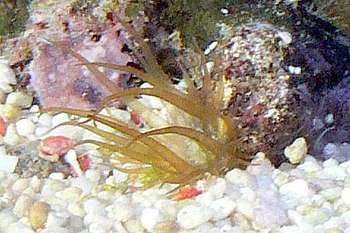 |
| Sea anemones : 1. Bolocera tuediae 2. Anthea cereus, 3. Aiptasia couchii, 4. Sagartia cocoinea, 5. Sagartia troglodytes (Photo credit: Wikipedia) |
Practically every reef-keeper can identify tales of the numerous hours put in checking out their new aquarium, observing to determine exactly what new life may appear from the liverock. It's virtually a magical period, particularly for someone new to reef-keeping, as the miracles of the sea gradually happen inside the modest glass world we've designed for it.
The majority of experiences which involve Aiptasia begin in exactly the same way. All of a sudden, a brand new little anemone is noticed on a freshly added item of liverock or live coral fragment, just a 'baby'... However, quickly that one 'baby' will become two, then several, then a lot more. By the time most reef-keepers realize who their new house guests happen to be, they quickly understand that this problem grows and multiplies at a very quick pace.
In keeping with their name, Aiptasia sp. Anemones (this means 'beautiful') tend to be exquisite critters, but they are additionally obtrusive and hostile competitors. Left uncontrolled, they will often completely over-run a fish tank. This doesn't take much time either, as we quickly discover.
Aiptasia has developed to be dominant neighbors and house-guests. They replicate both sexually and asexually, and they are effective at regenerating an entire creature from a single cell. Furthermore, they're armed and dangerous hunters! When Aiptasia are disrupted (possibly by way of a passing fish or invertebrate) they eject harmful white-colored stinging threads called Acontia which contain venomous tissues known as Nematocyst. These Nematocysts are designed for supplying a powerful sting that can cause tissue regression in sessile corals, immobilize prey, and even kill unlucky corals, crabs, snails or fish. Considered by many experienced reef enthusiasts as a pest (or worse), early identification and action are necessary to quickly remove Aiptasia from your tank before they reach epidemic proportions - making control/removal far more difficult.
Step one to managing an Aiptasia outbreak is proper identification. It accomplishes little to commit time and expense towards a means to fix the wrong issue.
 |
| Aiptasia sp. (Photo credit: Wikipedia) |
Aiptasia anemones could be revealed by their similarity to miniature palms, with a polyp body (the Coelenteron) up to two inches in length and an oral disc one inch across outlined with a combination of several prolonged and lots of small tentacles (up to one hundred tentacles may be found) situated in thin bands about the outside border of the oral disc. The tentacles tend to be lengthy slim protrusions that form well-defined tips at their ends.
In the middle of the oral disk is the mouth in the form of an elongated slit. At the bottom of the polyp, the body is the pedal disk which features as an anchor for the anemone in addition to a means of asexual duplication.
Pigmentation of Aiptasia is a result of the existence of Zooxanthellae (microscopic photosynthetic dinoflagellate alga - species Symbiodinium Microadriaticum). For this reason, specimens living in bright locations are often light greenish brown to dark brown, with those in areas which receive less light are typically medium to light brown or tan in color and those from low light areas tending toward a transparent appearance. Often an anemone's column or stalk is lightly marked with parallel longitudinal lines. Sometimes white or light green flecks can also be found close to the tentacles, and it's also not uncommon for juvenile specimens to be completely engrossed in them.
As with any members of the Cnidaria phylum, Aiptasia is able to sting for both offensive and defensive reasons. Just about all Cnidaria possess stinging cells called cnidocytes, each that includes a stinging mechanism, cnidae or nematocyst. Aiptasia has got both cnidocytes on their tentacles in addition to specialized cinclides around the lower area of the column (small blister-like protrusions) by which it expels acontia.
Acontia is threadlike protecting organs, made up mostly of stinging cnidocytes cells which can be expelled from the mouth and/or the customized cinclides once the Aiptasia is agitated. (A lot of anemones don't have acontia or cinclides yet Aiptasia does.)
The nematocysts of Aiptasia possess a contaminant which is stronger than the vast majority of corals held by the enthusiast (with the Elegance Coral - Catalaphyllia jardinei being one exception) and may cause cellular material regression in sessile corals, immobilize prey, as well as kill ill-fated crabs, snails or fish.
As an additional shielding mechanism, Aiptasia may also pull away into tiny holes inside your liverock if confronted. Taking advantage of this trait, it's possible to poke a diagnosed Aiptasia anemone with a probe and view its response. If it quickly pulls itself downwards (as opposed to folding in on itself), it's likely an Aiptasia.
Aiptasia is a formidable enemy, and pose a significant threat to any reef aquarium. Anyone harboring such species in their aquarium should look into natural predators, as chemical fixes don't work in the long run. Peppermint shrimp can often suppress Aiptasia, while Berghia Nudibranches can eradicate the problem pests.

No comments:
Post a Comment